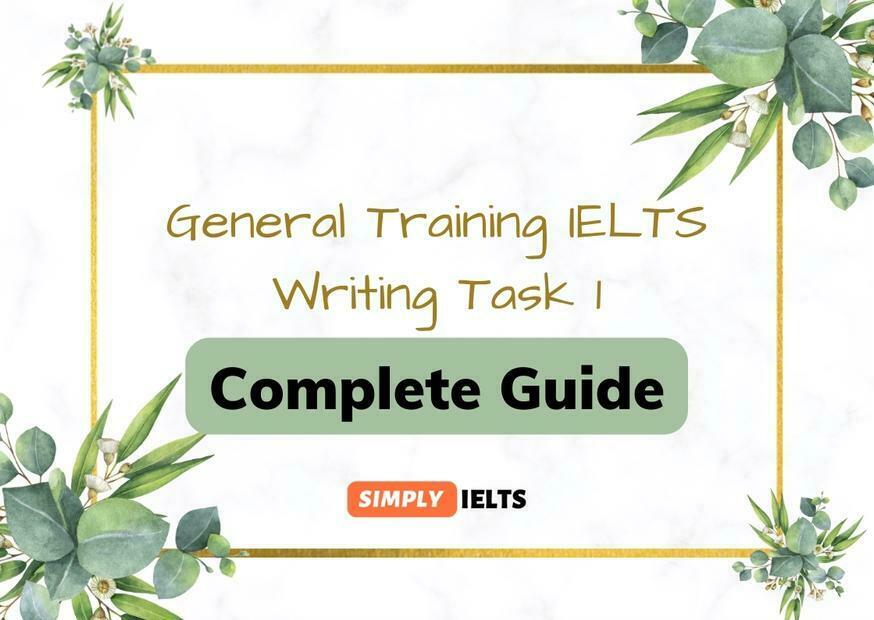A step by step guide to IELTS Writing Task 1 General Training
A step by step guide to IELTS Writing Task 1 General Training

Even after asking students not to focus on vocabulary and grammar while writing IELTS Letters, most of the students, unfortunately, concentrate only on those two aspects.
So, here I am trying to pen down a series of blogs on the IELTS Writing Task 1 on General Training or Letter Writing.
IELTS Letter writing demands that you write at least 150 words in about 20 minutes.
The task offers a situation, an addressee and three instructions using which you must decide the tone of the letter and write it.
While evaluating your work, the IELTS examiner looks for a sufficient explanation of your ideas and their interlinking.
They also evaluate your task based on the appropriate choice of words and sentence structures that a native speaker would use.
Table 1: IELTS Writing Section (General Training module)
| Writing Task 1 | Writing Task 2 | |
| Task | Write a letter. | Write an essay. |
| Total number of words you should write | At least 150 | At least 250 |
| Suggested distribution of 60 minutes | 20 minutes | 40 minutes |
Understanding the IELTS letter writing task
I know, the title may seem a bit odd. But, the thing is most of the students commit the mistake in comprehending the given set of instructions. Here, a sample letter is given.
You should spend about 20 minutes on the task.
You and your family are moving to another country and you are looking for a rented accommodation there.
Write a letter to a property agent.
In your letter…
- introduce yourself and your family
- describe the type of accommodation that you hope to find
- give your preference for the location of the accommodation
- Write at least 150 words. You do NOT need to write any addresses.
Begin your letter as follows:
Dear Sir or Madam,
At the beginning of the task, you will always read a suggestion that you should spend about 20 minutes on the task. After that, you will read a situation which is nothing but the circumstances under which you are writing the letter. Here, you are moving to another country with your family, and so you are searching for accommodation. Then you will read an addressee: a person who receives and reads this letter. In this task, it is a property agent.
Common mistake #1: Not paying attention to detail
Notice, the letter says that you are moving out of the country. Now, if you write that you want to move from Mumbai to Delhi, are you following the instruction? In fact, you have flouted one of the most important instructions. And, the examiner will definitely cut your marks here.
Afterwards, you will read three instructions for all tasks. The three instructions mentioned after stating the situation and the addressee are, in a way very essential. IELTS reader or examiner will be checking whether you have followed these three instructions or not quite closely.
Common mistake #2: Insufficient explanation
The first instruction asks you to introduce your family. Despite the clear instruction, students avoid any details thinking that it won’t serve any purpose. But understand, if you don’t explain details about your family sufficiently, you are not following the guidelines and stand to lose bands.
Then, the fourth instruction will always ask you to write a minimum of 150 words. The fifth instruction demands that you must begin the letter in a specific way. For most of the letters, these two instructions will never change. However, the instruction on how to begin the letter may differ from task to task, and hence you must pay attention to the fifth instruction for sure.
Comparing writing letters in school or college exams to that on IELTS
If you remember you wrote a letter in school that started with a date followed by the intended reader. You included the designation and even the organisation of the addressee. Then you would mention the subject of the letter and the reference of any previous correspondence.
After mentioning all these things, then you would start the actual letter. The after signing off in the end with your name on the letter, you would mention if anything was attached in the letter.
However, when it comes to IELTS, the examiner is not concerned about the date, the designation or the reference and even the attachment. They are more worried about the main letter, or in other words, he or she is concerned with the way you would communicate with others through the letter.
The preferred or ideal structure of letters on IELTS
In my experience, a letter that contains approximately 170 words can get maximum credit. The overall structure of the letter is the introduction paragraph, the body paragraphs and the end paragraph.
Introduction of the letter has about 30 words, and it helps us to set the tone of the letter. The body paragraphs are used to address the three main instructions of the letter. Lastly, the end paragraph consists of a request if any, future contact and a thank you. It consists of another 30 words. As we progress further, I will explain in detail how to write request and future contact.
Answer-sheet of the Writing Task 1 (Letter Writing)
However, the critical question is where to write a letter. The IELTS shall provide you with a writing answer sheet which would look very similar to the one shown on the screen.
If your handwriting is quite regular, that is you can write about eight words in one line, the answer-sheet (shown in the image) would be enough for you. In case needed, you can ask for a supplementary sheet in the examination.
Evaluation criteria for IELTS Writing Task 1 (General Training) or Letter Writing
There are four crucial evaluation criteria
- Task Achievement (TA)
- Coherence and Cohesion (CC)
- Lexical Resource (LR)
- Grammatical Range and Accuracy (GRA)
Let’s understand them one by one
1. Task Achievement (TA)
IELTS will give you full scores in this criterion if your letter has at least till 150 words with fully developed reasoning to back your position. Additionally, the letter should not have any repetition of ideas. And lastly, a suitable tone of the letter is an essential element of your writing. If you fail to add any of these components, you won’t be able to score well on Task Response.
2. Coherence and Cohesion (CC)
It deals with the overall structure of the letter.
Coherence asks for clear ideas which are organised logically. It simply means that the ideas which help you to explain your points must leave no ambiguity in the reader’s mind.
At the same time, Cohesion deals with the appropriate usage of cohesive devices and checks whether the letter has a clear-cut representation of instructions in the paragraphs. In short, if your letter contains well-developed ideas organised in appropriate paragraphs, you can full score well on Coherence and Cohesion.
3. Lexical Resource (LR)
The reader or evaluator checks whether you have used a range of words without compromising the meaning of the sentence. And, so you must use all your words with precision. The examiner will also be impressed if you could use typical phrases and collocations used by the native speakers.
Lastly, he or she will also look for spelling mistakes.
Yet keep in mind IELTS will ignore a few minor spelling mistakes which actually don’t change the meaning of the sentence.
4. Grammatical Range and Accuracy
According to the norm, you should be able to use tenses appropriately. The IELTS examiner would be very happy to see a variety of sentence structures which are used accurately.
Lastly, your writing must also have appropriate punctuations without any mistakes.
Essential and additional criteria
Apart from the criteria we discussed just now, there are few additional aspects which IELTS examiner will look for.
- The evaluator must count the number of words in the letter and ensure that 150 words are written. If your letter falls short, you will be penalised. At the same time, IELTS does not restrict you to the highest number of words.
- Before submitting your paper, check whether the letter is not off-topic. Your bands will be deducted if you don’t stick to the given topic.
- If your response seems to be memorised or copied, you stand to lose a lot.
- If your handwriting is not readable or in other words legible your bands will be affected for sure. Remember you will not get any extra credit for clean handwriting just the way you might have got when you were in school.
On the actual exam day
Problem with tracking time during the exam
On the IELTS exam, you are not allowed to carry your wristwatch or mobile phone in the exam hall. So, the question is, how will keep track of time? The only way to keep track of time is this digital countdown on the screen.
This countdown will go from 60 minutes to zero. IELTS examiner will not warn or suggest you switch the writing task after 20 minutes. It is your responsibility.
Solution
In fact, in the examination hall, you will receive question and answer sheets for both writing tasks together. You may choose to write either of the tasks first.
That is, you may choose to write the first task initially or even the second one. It doesn’t matter. All that matters, for the invigilator, is that you complete the writing section in 60 minutes.
Frequently asked questions about letter writing
How many words should I write?
I have partially answered this question already, still, I will touch upon additional points. You should aim to write about 170 words in the letter.
A letter with a lesser number of words might not be able to explain the views sufficiently. In contrast, a letter with more than 200 words might be too lengthy to finish in the given time.
Do they really count articles like ‘a’, ‘an’ and ‘the’?
The straightforward answer is yes. IELTS examiner count anything that contributes to the meaning of a sentence.
Summary
In short, we have looked through the basics of Writing Task 1. You have understood that situation, addressee and three instructions are quite essential to understand the scope of the letter.
And, there are four essential evaluation criteria Task Achievement, Coherence and Cohesion, Lexical Resource, and Grammatical Range and Accuracy.





Responses